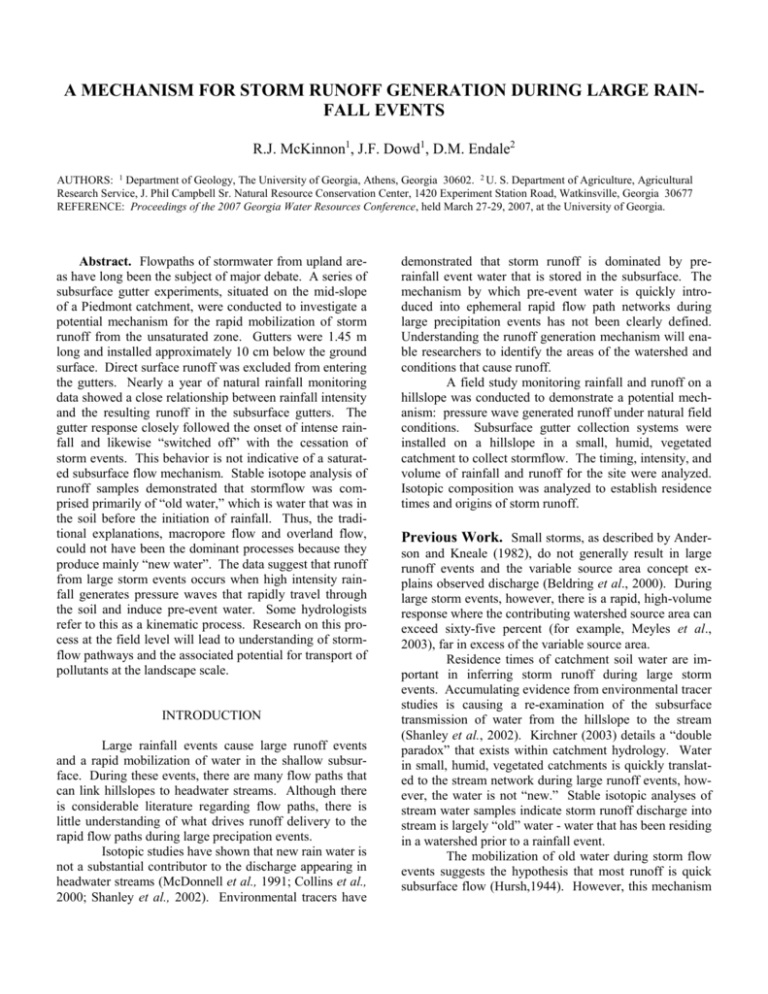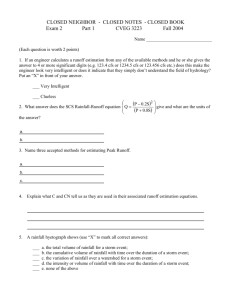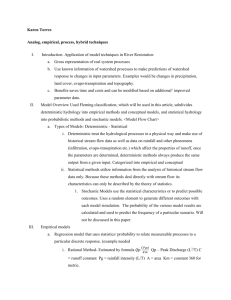introduction - Georgia Water Resources Conference
advertisement

A MECHANISM FOR STORM RUNOFF GENERATION DURING LARGE RAINFALL EVENTS R.J. McKinnon1, J.F. Dowd1, D.M. Endale2 AUTHORS: 1 Department of Geology, The University of Georgia, Athens, Georgia 30602. 2 U. S. Department of Agriculture, Agricultural Research Service, J. Phil Campbell Sr. Natural Resource Conservation Center, 1420 Experiment Station Road, Watkinsville, Georgia 30677 REFERENCE: Proceedings of the 2007 Georgia Water Resources Conference, held March 27-29, 2007, at the University of Georgia. Abstract. Flowpaths of stormwater from upland areas have long been the subject of major debate. A series of subsurface gutter experiments, situated on the mid-slope of a Piedmont catchment, were conducted to investigate a potential mechanism for the rapid mobilization of storm runoff from the unsaturated zone. Gutters were 1.45 m long and installed approximately 10 cm below the ground surface. Direct surface runoff was excluded from entering the gutters. Nearly a year of natural rainfall monitoring data showed a close relationship between rainfall intensity and the resulting runoff in the subsurface gutters. The gutter response closely followed the onset of intense rainfall and likewise “switched off” with the cessation of storm events. This behavior is not indicative of a saturated subsurface flow mechanism. Stable isotope analysis of runoff samples demonstrated that stormflow was comprised primarily of “old water,” which is water that was in the soil before the initiation of rainfall. Thus, the traditional explanations, macropore flow and overland flow, could not have been the dominant processes because they produce mainly “new water”. The data suggest that runoff from large storm events occurs when high intensity rainfall generates pressure waves that rapidly travel through the soil and induce pre-event water. Some hydrologists refer to this as a kinematic process. Research on this process at the field level will lead to understanding of stormflow pathways and the associated potential for transport of pollutants at the landscape scale. INTRODUCTION Large rainfall events cause large runoff events and a rapid mobilization of water in the shallow subsurface. During these events, there are many flow paths that can link hillslopes to headwater streams. Although there is considerable literature regarding flow paths, there is little understanding of what drives runoff delivery to the rapid flow paths during large precipation events. Isotopic studies have shown that new rain water is not a substantial contributor to the discharge appearing in headwater streams (McDonnell et al., 1991; Collins et al., 2000; Shanley et al., 2002). Environmental tracers have demonstrated that storm runoff is dominated by prerainfall event water that is stored in the subsurface. The mechanism by which pre-event water is quickly introduced into ephemeral rapid flow path networks during large precipitation events has not been clearly defined. Understanding the runoff generation mechanism will enable researchers to identify the areas of the watershed and conditions that cause runoff. A field study monitoring rainfall and runoff on a hillslope was conducted to demonstrate a potential mechanism: pressure wave generated runoff under natural field conditions. Subsurface gutter collection systems were installed on a hillslope in a small, humid, vegetated catchment to collect stormflow. The timing, intensity, and volume of rainfall and runoff for the site were analyzed. Isotopic composition was analyzed to establish residence times and origins of storm runoff. Previous Work. Small storms, as described by Anderson and Kneale (1982), do not generally result in large runoff events and the variable source area concept explains observed discharge (Beldring et al., 2000). During large storm events, however, there is a rapid, high-volume response where the contributing watershed source area can exceed sixty-five percent (for example, Meyles et al., 2003), far in excess of the variable source area. Residence times of catchment soil water are important in inferring storm runoff during large storm events. Accumulating evidence from environmental tracer studies is causing a re-examination of the subsurface transmission of water from the hillslope to the stream (Shanley et al., 2002). Kirchner (2003) details a “double paradox” that exists within catchment hydrology. Water in small, humid, vegetated catchments is quickly translated to the stream network during large runoff events, however, the water is not “new.” Stable isotopic analyses of stream water samples indicate storm runoff discharge into stream is largely “old” water - water that has been residing in a watershed prior to a rainfall event. The mobilization of old water during storm flow events suggests the hypothesis that most runoff is quick subsurface flow (Hursh,1944). However, this mechanism Site Description. The study area, as described by Endale et al. (2002), is a humid, vegetated watershed centered in the Southern Piedmont Physiographic Province. The experimental watershed is located at the J. Phil Campbell, Senior, Natural Resource Conservation Center, a part of the Agricultural Research Service agency of the United States Department of Agriculture, in Watkinsville, GA, about 12km south of Athens, GA. The hillslope soil is a sandy loam of the Cecil soil series (fine, kaolinitic, thermic Typic Kanhapludult) (Endale et al., 2002). Methods. Rainfall/runoff collection systems were installed on a hillslope plot (13 m x 10 m) in the mid-slope region. There were two replications of a subsurface runoff gutter collection systems. Repetition 1 (left) and Repetition 2 (right) are shown in Figure 1. Rainfall and runoff were monitored for nearly one year. An ONSET tipping bucket rain gauge with a HOBO Event data logger was vertically mounted approximately 0.5 m above ground and used to record rainfall volume at 0.01 in intervals. Raingauge Rainfall Collector . . . Tipping Bucket Counter for Rainfall (15cm. depth) Tipping Bucket Counter for Seepage + Tensiometer Lysimeter + + + Gutter Gutter Tensiometer (40cm. depth) . . . + + + } Rasmussen et al. (2000) discusses a laboratory soil core tracer experiment that implies a kinematic flow process. The experiment utilized three intact saprolite columns that were irrigated by misting 0.3 mm of water, calcium chloride tracer, and flush water at various intervals in a repeating cycle. The cores were held at nearsaturation and were outfitted with micro-tensiometers at various depths to measure soil tension at one minute intervals. The tracer velocity through the saprolite cores was consistent with preferential flow and took approximately two days for the chloride peak to appear in the uppermost lysimeter. Within minutes of mist application, however, some water was ejected from the core bottom. Rasmussen et al. (2000) found that the pressure wave celerity was approximately 1000 times faster than the chloride tracer velocity. Torres (2002) discusses a study where tracer data from an irrigation experiment showed no spike increases in fluid pressure throughout the system. Therefore, it is likely that the tension response that indicates pressure wave translatory flow is related primarily to perturbation by rainfall, as demonstrated in Rasmussen et al. (2000). There is a pressure gradient between surrounding soils and macropores that keeps water from sitting in the rapid flow routes. A decrease in the pressure to near-zero leads to enhanced drainage and a release of water into the macropores (Torres and Alexander, 2002). Each runoff collection system consisted of two trenches in which 1.25 m long gutters were inserted to collect subsurface stormflow. Steel plates were driven at . does not explain the size and timing of most storm hydrographs. Storage Reservoirs (15cm. depth) Lysimeter 1 meter (40cm. depth) Figure 1. Watkinsville Study Plot--Map View. an angle into the upslope soil face, approximately 10 cm at depth just above the Bt horizon to facilitate the seepage collection into the gutters. The drip plates induce soil water conditions similar to incipient channels or pipe-flow at a seepage face. A near-saturated wedge collects at the lip and transmits flow across the steel plate, which in turn drips into the gutters (Figure 2). The trenches were covered so that no direct precipitation or saturation overland flow could enter the subsurface gutters. Gutter flow was directed to an ONSET tipping bucket rain gauge that measured the volume and timing of flow. Figure 2. Gutter Design. Stable isotopic analyses (deuterium) was conducted on the rainfall, runoff, and soil water samples that were collected following runoff generating storm events. Soil water was collected from suction lysimeters. Results and Discussion. During the experimental monitoring period, fifty-one storm events were recorded. Although each event entails a unique combination of rain- Figure 3. Rainfall and Gutter Response. The largest storm on record (3.91 in) took place on October 6-7, 2005, as shown in Figure 4. This storm exhibited a rapid initiation of gutter flow and the abrupt on/off periods that mirrored the rainfall. Both gutter collection systems typically displayed similar results in timing and flow rates. A storm that took place on April 22-23, 2005, is shown in Figure 5. Although it is a fairly small storm (0.42 in), it had the largest volume relative to rainfall. Early gutter response for this storm shows that gutter flow rate is dependent upon rainfall intensity. Event 38 380 2,100 Raingauge Subsurface Gutter 1 Subsurface Gutter 2 360 2,000 340 1,900 320 1,800 Gutter Tips 1,600 280 1,500 260 1,400 240 1,300 220 1,200 200 1,100 180 1,000 900 160 800 140 700 120 600 100 500 80 400 60 300 40 200 20 100 0 10/6/2005 10/6/2005 10/6/2005 10/7/2005 10/7/2005 10/7/2005 0 10/7/2005 Date Figure 4. Rainfall/runoff, Oct. 6-7, 2005. Raingauge Tips 300 1,700 Event 14 40 600 Raingauge Subsurface Gutter 1 Subsurface Gutter 2 Rainfall Rep. 1 Rainfall Rep. 2 38 36 550 34 500 32 30 450 26 24 350 22 20 300 18 250 16 Raingauge Tips 28 400 Gutter Tips fall/runoff responses, deuterium composition, and antecedent conditions, representative storms will be used to summarize the response. Deuterium analysis of the gutter flow confirmed that runoff was similar to the lysimeter soil water isotopic value, thus old water dominated the gutter flow. Figure 3 shows a typical subsurface gutter response to rainfall. After an initial lag the gutter flow mimics the rainfall, starting and stopping abruptly with rainfall. The initial lag is due to wetting of the hillslope, the amount required is dependent on antecedent conditions. Gutter flow only occurred when the hillslope was reasonably wet. Once the hillslope is “primed”, the gutter flow consistently responds within minutes to the onset of rain. Similarly, within a few minutes after rainfall stops, the gutter stops. 14 200 12 10 150 8 100 6 4 50 2 0 0 3:00 PM 4:00 PM 5:00 PM 6:00 PM 7:00 PM 8:00 PM 9:00 PM 10:00 PM 11:00 PM 12:00 AM 1:00 AM Time Figure 5. Rainfall/runoff, Apr. 22, 2005. The behavior of the gutters is inconsistent with either saturated or unsaturated subsurface flow. Flow abruptly commences in the gutters with a constant rate; flow abruptly ceases after rainfall ends. This is not consistent with Darcian flow. The presence of old water in the gutters eliminates the possibility that the site is dominated by traditional macropore flow or Hortonian overland flow. In addition, no water table was observed in the pits. A pressure wave process, however, is consistent with all of the observed behavior. Conclusions. The gutter experiment was designed to simulate the response in an ephemeral network. The behavior of the gutters demonstrates a pressure wave phenomenon delivering water to the pathway. On a watershed scale, this ephemeral network will grow or shrink during a storm, delivering water to the perennial stream. Future work will be directed towards identifying this network, thus the runoff generating areas of a small watershed. LITERATURE CITED Anderson, M.G., and P.E. Kneale, 1982. The influence of low angled topography on hillslope soil-water convergence and stream discharge. Journal of Hydrology, 57: 65-80. Beldring, S., S. Gottschalk, A. Rodhe, and L.M. Tallak sen, 2000. Kinematic wave approximations to hillslope hydrological processes. Hydrological Processes, 14: 727-745. Collins, R. A. Jenkins, and M. Harrow, 2000. The contribution of old and new water to a storm hydrograph determined by tracer addition to a whole catchment. Hydrological Processes, 14: 701-711. Endale, D., M. Cabrera, J. Steiner, D. Radcliffe, W. Ven cill, H. Schomberg, L. Lohr, 2002. Impact of conserva tion tillage and nutrient management on soil water and yield of cotton fertilized with poultry litter and or am monium nitrate in the Georgia Piedmont. Soil and Till age Research, 66: 55-68. Hursh, C.R., 1944. Report of subcommittee on subsurface flow. Transactions of the American Geophysical Union, Part V, pp. 745-746. Kirchner, J.W., 2003. A double paradox in catchment hydrology. Hydrologic Processes, 17: 871-874. McDonnell, J.J., M.K. Stewart, and I.F. Owens, 1991. Effect of catchment-scale subsurface mixing on stream isotopic response. Water Resources Research, 27: 0653073. Meyles, E., A. Williams, L. Ternan, and J. Dowd, 2003. Runoff generation in relation to soil moisture patterns in a small Dartmoor catchment, Southwest England. Hy drological Processes, 17: 251-264. Rasmussen, T., R.H. Baldwin, J. Dowd, and A. Williams, 2000. Tracer vs. pressure wave velocities through unsaturated saprolite. Soil Science Society of America Journal, 64(1): 75-85. Shanley, J., C. Kendell, T. Smith, D. Wolock, and J. McDonnell, 2002. Controls on old and new water con tributions to stream flow at some nested catchments in Vermont, USA. Hydrologic Processes, 16: 589609.Torres, R., 2002. A threshold condition for soilwater transport. Hydrological Processes, 16: 27032706. Torres, R., and L. Alexander, 2002. Intensity-duration effects on drainage: Column experiments at near-zero pressure head. Water Resources Research, 38(11): 221225.







